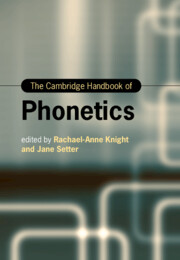Book contents
- The Cambridge Handbook of Phonetics
- Cambridge Handbooks in Language and Linguistics
- The Cambridge Handbook of Phonetics
- Copyright page
- Contents
- Figures
- Tables
- Contributors
- Introduction
- Section I Segmental Production
- 1 Physiological Foundations
- 2 Vowels
- 3 Consonants
- 4 Coarticulation
- 5 Processes in Connected Speech
- Section II Prosodic Production
- Section III Measuring Speech
- Section IV Audition and Perception
- Section V Applications of Phonetics
- Index
- References
3 - Consonants
from Section I - Segmental Production
Published online by Cambridge University Press: 11 November 2021
- The Cambridge Handbook of Phonetics
- Cambridge Handbooks in Language and Linguistics
- The Cambridge Handbook of Phonetics
- Copyright page
- Contents
- Figures
- Tables
- Contributors
- Introduction
- Section I Segmental Production
- 1 Physiological Foundations
- 2 Vowels
- 3 Consonants
- 4 Coarticulation
- 5 Processes in Connected Speech
- Section II Prosodic Production
- Section III Measuring Speech
- Section IV Audition and Perception
- Section V Applications of Phonetics
- Index
- References
Summary
Consonants are speech sounds produced with a closure or near complete constriction of the vocal tract. All languages systematically exploit place of articulation to differentiate consonants. Eight other phonetically independent parameters are used to create consonant contrast: airstream, constriction degree, laryngeal setting, nasality, laterality, length, articulator stiffness, and respiratory strength. Aspiration, affrication, pre-stopping, secondary articulations, and other properties of ‘complex’ consonants are best described as patterns of coordination in the underlying gestures.
- Type
- Chapter
- Information
- The Cambridge Handbook of Phonetics , pp. 65 - 105Publisher: Cambridge University PressPrint publication year: 2021

